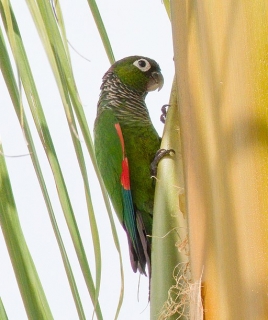Maroon-tailed Conure |
|
|
Also known as: Maroon-tailed Parakeet, Black-tailed Conure or Parakeet, Souance's Conure or Parakeet (P.m. souancei)
Photos
View in GalleryDid You Know?
Conures are avid bathers. They love to splash about in water, becoming thoroughly drenched. Some conures are stimulated to bathe by the sound of running water.Academic Research
Related publications: Pyrrhura melanuraSpecies Profile
Genus: Pyrrhura | Species: melanura
Size:
24cm (9.4 in)
Weight:
83-85g (3-3.3 oz)
Subspecies including nominate:
four: P.m. melanura, P.m. souancei, P.m. berlepschi
Colour Adult:
P.m. melanura: Both adults crown to nape coloured brown, with obvious green margins to feathers; cheeks and ear coverts green; breast green with white/buff and brown scalloping; primary coverts red, widely tipped with orange/yellow; tail dark brown/red, thinly marked green toward base. Bill pale grey. Eye ring bare and white, eye brown.
P.m. souancei: Both adults as in melanura, but with dusky brown wash on breast and more widely marked grey/white; no orange/yellow tips to red primary coverts; varying red feathers on carpal (wrist) edge on wing; abdomen tinged brown/red, forming, in some birds, a faded patch; tail more widely green toward base.
P.m. berlepschi: Both adults as in souancei, but feathers on breast tipped dusky brown and more widely barred with grey/white, in some birds appearing almost completely white; cheeks brighter green tinted with olive; uniform red on carpal edge; abdomen more uniformly tinted brown/red.
Colour Juvenile:
As in adults but with fainter marking on breast, shorter tail and paler grey bill.
Call:
Calls have been noted particularly harsh, especially those in flight, repeated quickly and often from many members of group.
Listen NowVideo Links:
Video 1More Information:
Content Sources:
CITES
BirdLife International
Cornell Lab of Ornithology/Birds of the World
Parrots: A Guide to Parrots of the World, Juniper and Parr, 1998
ML Media Collection Catalogue 29333, Maroon-tailed Parakeet Pyrrhura melanura, Parker, Theodore A., III, Loreto, Peru, Jun. 1 1982, Cornell Lab of Ornithology. Site
A Guide to Popular Conures as Pet and Aviary Birds, Dorge and Sibley, 2001.
Parrots of the World, Forshaw, 2006. 2010 edition
Parrots in Aviculture, Low, 1992.
Lexicon of Parrots, Thomas Arndt.
Photos
View in GalleryDid You Know?
Conures are avid bathers. They love to splash about in water, becoming thoroughly drenched. Some conures are stimulated to bathe by the sound of running water.Academic Research
Related publications: Pyrrhura melanuraSpecies Care
Captive Status:
Uncommon
Longevity:
As with other Pyrrhura species probably between 15-25 yrs.
Housing:
Aviary or suspended enclosure, minimum length 2m (6.5 ft).
Diet:
Fruit such as: apple, pear, orange, cactus fruits, pomegranate, forming about 30 percent of diet; vegetables such as: carrot, celery, green peas and beans, corn; green leaves such as: Swiss chard, lettuce, sowthistle, dandelion, chickweed; spray millet; small seed mix such as: canary, millet, safflower, oats, buckwheat; soaked and sprouted sunflower; cooked beans and pulses, and complete pellet.
Enrichment:
Provide planted aviary if possible, and provide bird-safe chewable wood and toys. Enjoys bathing, so provide overhead misters or shallow water bowls.
Nest Box Size:
8" x 8" x 28" (20.3cm x 20.3cm x 71cm) vertical box.
Clutch Size:
4 or 5
Incubation Time:
23 days
Fledging Age:
7 weeks
Hatch Weight:
Not recorded.
Peak Weight:
Not recorded.
Weaning Weight:
Not recorded.
Photos
View in GalleryDid You Know?
Conures are avid bathers. They love to splash about in water, becoming thoroughly drenched. Some conures are stimulated to bathe by the sound of running water.Academic Research
Related publications: Pyrrhura melanuraSpecies Wild Status
World Population:
Unknown, decreasing.
IUCN Red List Status:
Least Concern
CITES Listing:
Appendix II
Threat Summary:
Not globally threatened. Generally fairly common, and in places in S Colombia the most numerous parrot. Now virtually no trade anywhere in range, but was traded in significant numbers internationally in the late 1980s. Minimal habitat loss in Venezuela.
Range:
P.m. melanura: Upper Amazon River basin, from SE Colombia in SE Guainia, Vaupes and Amazonas, and S Venezuela, in Amazonas and E Bolivar, to Rio Negro And Rio Solimoes and tributaries, NW Brazil, and middle to lower Rio Napo drainage in E Ecuador and NE Peru.
P.m. souancei: Eastern lowlands of Andes in S Colombia, south from Macarena Mountains, in E Ecuador, and possibly in N Peru.
P.m. berlepschi: Lowland eastern slopes of Andes in Morona-Santiago, SE Ecuador, and E Peru, south to Rio Huallaga valley.
Habitat:
Found in varied habitats from tropical to temperate zone areas including varzea, lowland and low mountainous rainforest and cloud forest, often in partly cleared areas and edges. Also secondary forest. Up to 3200m (10,496 ft).
Wild Diet:
Diet includes fruits of Trema micrantha, Erythrina, cultivated mangoes and guavas; also Miconia theaezans and other Melastomataceae. Fagara (Zanthoxylum) tachuelo, tree bark and seeds also seen. Also recorded also feeding on fruits of Euterpe oleracea and other palms.
Ecology and Behaviour:
Seen in groups of 6-12 individuals, keeping to canopy and tree top areas. Moves to lower branches to forage for food. May be seasonally nomadic in some parts of Colombia.
Clutch and Egg Size:
4 or 5 eggs
Breeding Season:
April-June.
Related Links:
Photos
View in GalleryDid You Know?
Conures are avid bathers. They love to splash about in water, becoming thoroughly drenched. Some conures are stimulated to bathe by the sound of running water.Academic Research
Related publications: Pyrrhura melanuraMembers Only Resources
Please log-in now to find more research, resources and tools.
Not a Member?
Find more great information:
Gain exclusive access to 600+ pages of additional research, seminars and podcasts, specialists to ask your toughest questions, and dozens of other fun resources - when you become a WPT member.
Join Today >>

































